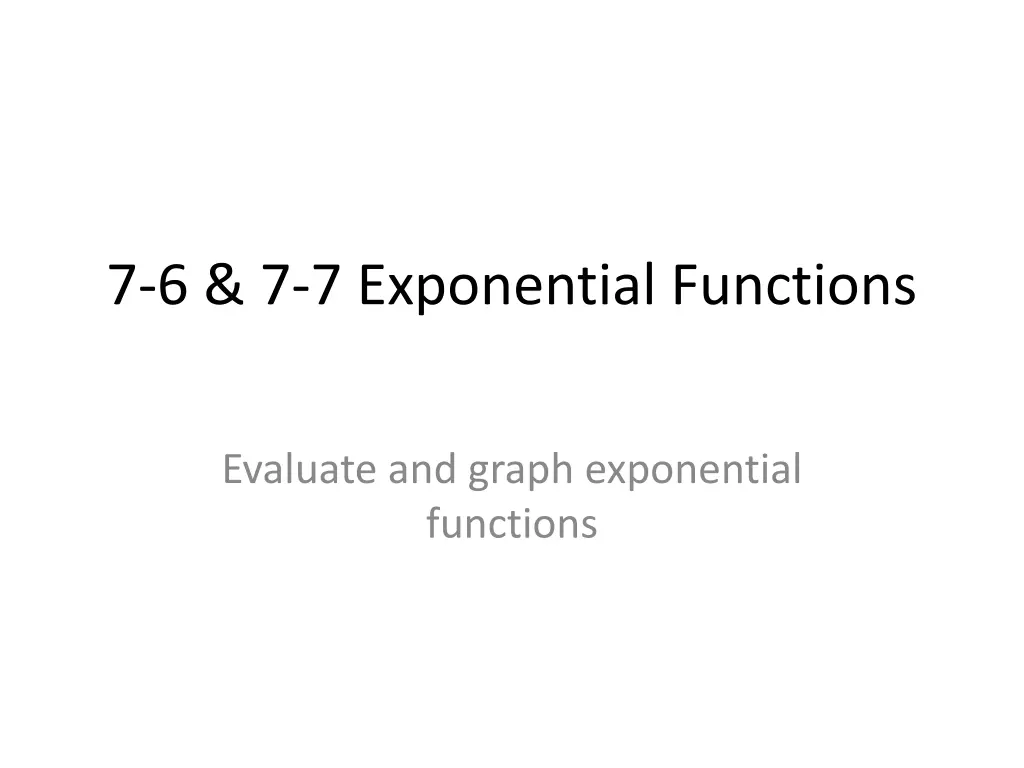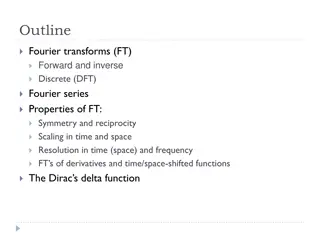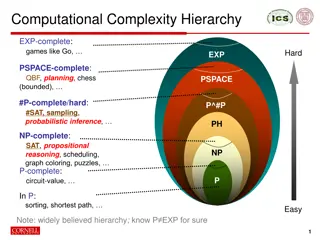
Understanding Exponential Functions and Graphing
Explore exponential functions, growth, decay, and how to evaluate and graph them. Delve into examples, growth factors, decay factors, and linear vs. exponential functions. Discover scenarios like beetle population growth and restaurant spending trends.
Download Presentation

Please find below an Image/Link to download the presentation.
The content on the website is provided AS IS for your information and personal use only. It may not be sold, licensed, or shared on other websites without obtaining consent from the author. If you encounter any issues during the download, it is possible that the publisher has removed the file from their server.
You are allowed to download the files provided on this website for personal or commercial use, subject to the condition that they are used lawfully. All files are the property of their respective owners.
The content on the website is provided AS IS for your information and personal use only. It may not be sold, licensed, or shared on other websites without obtaining consent from the author.
E N D
Presentation Transcript
7-6 & 7-7 Exponential Functions Evaluate and graph exponential functions
Exponential function A function in the form of y = ? ?? Examples:
Exponential Growth, modeled by the following y = a ?? Initial amount (this is when x = 0) ? = ? ?? exponent The base & when b>1, called the Growth factor (1 + the percent rate written as a decimal)
Exponential Decay Initial amount (this is when x = 0) ? = ? ?? exponent The base is the decay factor (1 minus percent rate written as a decimal)
Evaluate the function for the given value. ? = 3 4? for x = 3 ? = 3 4( ) 3 ? = 3 64 ? = 192
What is the graph of y = 3 2?? Does the graph represent growth or decay? growth y = 3 2? (x, y) x 10 9 y = 3 2 2 (-2, 3 -2 4) 8 7 c c 6 y = 3 2 1 (-1, 1 1 -1 2) 5 4 y = 3 20 0 3 (0, 3) 2 1 1 y = 3 21 0 (1, 6) -1 -2 y = 3 22 2 (2, 12) -5 -4 -3 -2 -1 0 1 2 3 4 5
Does the table or rule represent a linear or an exponential function? A. ANSWER: EXPONENTIAL FUNCTION. x y B. y = 3x 0 0 1 3 ANSWER: LINEAR FUNCTION. 2 6 3 9
Suppose 30 flour beetles are left undisturbed in a warehouse bin. The beetle population doubles each week. The function f(x) = 30 2? gives the population after x weeks. How many beetles will there be after 56 days? will there be after 56 days? Suppose 30 flour beetles are left undisturbed in a warehouse bin. The beetle population doubles each week. The function f(x) = 30 2? gives the population after x weeks. How many beetles f(x) = 30 2? What does x represent? = 30 28 = 30 256 = 7680 Answer: after 56 days, there will be 7,680 flour beetles.
Since 2005, the amount of money spent at restaurants in the US has increased about 7% each year. In 2005, about $360 billion was spent at restaurants. If the trend continues, about how much will be spent at restaurants in 2018? ? = ? ?? Let y = The annual amount spent in restaurants (in billions of dollars) Let a = The initial amount: 360 Let b = The growth factor: (1 + %) or 1 + .07 = 1.07 Let x = The number of years since 2005: 13 ? = 360 1.0713 ? = 867.5442001 ? = $867.5 billion ?? $868 ???????
The kilopascal is a unit of measure for atmospheric pressure. The atmospheric pressure at sea level is about 101 kilopascals. For every 1000-m increase in altitude, the pressure decreases about 11.5%. What is the approximate pressure at an altitude of 3000 m? ? = ? ?? Let y = The atmospheric pressure (in kilopascals) Let a = The initial amount: 101 Let b = The decay factor: (1 - %) or 1 - .115 = .885 3 Let x = The altitude (in thousands of meters) ? = 101 .8853 ? = 70.0085 ? = 70 kilopascals
When a bank pays interest on both the principal and the interest an account has earned. (it uses the following formula) r = the annual interest rate--- -convert from % to a decimal (move 2 places to the left) Compound interest: A = The balance r n)nt t= the time in years A = P( 1 + P = the principal (the initial deposit) n = the number of times interest is compounded per year
Find the balance in the account after the given period: $12,000 principal earning 4.8% compounded annually, after 7 years 12,000 .048 1 7 P = r = n = t = r n)nt A = P( 1 + A = 12,000( 1 +.048 )1(7) 1 A = $16,661.35
Find the balance in the account after the given period: $20,000 principal earning 3.5% compounded monthly, after 10 years 20,000 .035 12 10 P = r = n = t = r n)nt A = P( 1 + A = 20,000( 1 +.035 12)12(10) A = $28,366.90
Pg 457: 18,19 pg 464: 9-21 odd (skip 13) Pg 457: 18,19 pg 464: 9,15,17,19,21






















